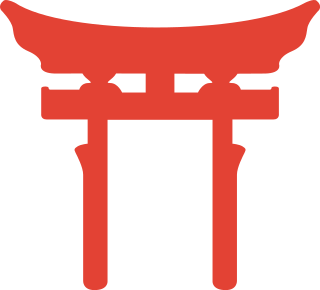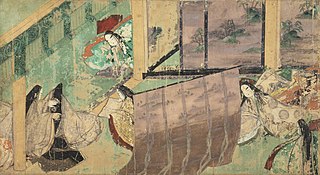
Japanese festivals are traditional festive occasions. Some festivals have their roots in Chinese festivals centuries ago, but have undergone great changes as they mixed with local customs.

Inari Ōkami is the Japanese kami of foxes, of fertility, rice, tea and sake, of agriculture and industry, of general prosperity and worldly success, and one of the principal kami of Shinto. In earlier Japan, Inari was also the patron of swordsmiths and merchants. Represented as male, female, or androgynous, Inari is sometimes seen as a collective of three or five individual kami. Inari appears to have been worshipped since the founding of a shrine at Inari Mountain in 711 AD, although some scholars believe that worship started in the late 5th century.

The Heian Shrine is a Shinto shrine located in Sakyō-ku, Kyoto, Japan. The Shrine is ranked as a Beppyō Jinja (別表神社) by the Association of Shinto Shrines. It is listed as an important cultural property of Japan.

The Aoi Matsuri (葵祭), or "Hollyhock Festival," is one of the three main annual festivals held in Kyoto, Japan, the other two being the Festival of the Ages and the Gion Festival. It is a festival of the two Kamo shrines in the north of the city, Shimogamo Shrine and Kamigamo Shrine. The festival may also be referred to as the Kamo Festival. It is held on 15 May of each year.

Kasuga Grand Shrine is a Shinto shrine in the city of Nara, in Nara Prefecture, Japan. Established in 768 CE and rebuilt several times over the centuries, it is the shrine of the Fujiwara family. The interior is famous for its many bronze lanterns, as well as the many stone lanterns that lead up the shrine.
Suijin is the Shinto god of water in Japan. The term Suijin refers to the heavenly and earthly manifestations of the benevolent Shinto divinity of water. However, it also refers to a wide variety of mythological and magical creatures found in lakes, ponds, springs and wells, including serpents, eels, fish, turtles, and the flesh-eating kappa. As Mizu no Kamisama, Mizugami, or Suijin, this kami is widely revered in Japan, being a big part of Japanese culture, and is often worshiped in temples. Suijin is also known as the Water god, Suiten (水天) and Sui-ō/Suiu (水王).

Fushimi Inari Taisha (伏見稲荷大社) is the head shrine of the god Inari, located in Fushimi Ward in Kyoto, Japan. The shrine sits at the base of a mountain also named Inari which is 233 metres (764 ft) above sea level, and includes trails up the mountain to many smaller shrines which span 4 kilometres (2.5 mi) and take approximately 2 hours to walk up.

Dazaifu Tenman-gū (太宰府天満宮) is a Shinto shrine in Dazaifu, Fukuoka Prefecture, Japan. It is built over the grave of Sugawara no Michizane (845–903) and is one of the main shrines dedicated to Tenjin, the deified form of Michizane.

In mythology, folklore and the Shinto religion of Japan, Tenjin (天神) is the kami (deity) of Academics, Scholarship and Learning.

The Shinto Kanamara Matsuri(かなまら祭り, "Festival of the Steel Phallus") is held each spring at the Kanayama Shrine in Kawasaki, Japan. The exact dates vary: the main festivities fall on the first Sunday in April. The phallus, as the central theme of the event, is reflected in illustrations, candy, carved vegetables, decorations, and a mikoshi parade.

The traditional lighting equipment of Japan includes the andon (行灯), the bonbori (雪洞), the chōchin (提灯), and the tōrō (灯篭).

The Fujisan Hongū Sengen Taisha (富士山本宮浅間大社) is a Shintō shrine in the city of Fujinomiya in Shizuoka Prefecture, Japan. It is the ichinomiya of former Suruga Province, and is the head shrine of the 1300 Asama or Sengen shrines in the country. The shrine has an extensive location within downtown Fujinomiya; in addition, the entire top of Mount Fuji from the 8th stage upwards is considered to be part of the shrine grounds.

Hatogamine Hachiman Shrine is a Shintō shrine in Tokorozawa, Saitama Prefecture, Japan.

Kumano Nachi Taisha (熊野那智大社) is a Shinto shrine and part of the UNESCO-designated World Heritage Sacred Sites and Pilgrimage Routes in the Kii Mountain Range of Japan. The Kumano Kodō route connects it to other sites under the same classification, which are primarily located in Wakayama Prefecture, Japan. The four sites on the route, classified as pilgrimage destinations and World Heritage Sites, are: 1) Nachi Taisha; 2) Hongū Taisha; 3) Hayatama Taisha; 4) Koya-san.

Sanja Matsuri, or Sanja Festival, is one of the three great Shinto festivals in Tokyo. It is considered one of the wildest and largest. The festival is held in honor of Hinokuma Hamanari, Hinokuma Takenari, and Hajino Nakatomo, the three men who established and founded the Sensō-ji Buddhist temple. Sanja Matsuri is held on the third weekend of every May at Asakusa Shrine. Its prominent parades revolve around three mikoshi, as well as traditional music and dancing. Over the course of three days, the festival attracts 1.5 to 2 million locals and tourists every year.

The Katori Shrine is a Shintō shrine in the city of Katori in Chiba Prefecture, Japan. It is the ichinomiya of former Shimōsa Province, and is the head shrine of the approximately 400 Katori shrines around the country.

Hiyoshi Taisha is a Shinto shrine located in Ōtsu, Shiga, Japan. This shrine is one of the Twenty-Two Shrines. Hiyoshi Shrine, also known as Hiyoshi jinja (日吉神社) or Hie jinja.

Usa Jingū (宇佐神宮), also known as Usa Hachimangū (宇佐八幡宮), is a Shinto shrine in the city of Usa in Ōita Prefecture in Japan. Emperor Ojin, who was deified as Hachiman-jin, is said to be enshrined in all the sites dedicated to him; and the first and earliest of these was at Usa in the early 8th century. The Usa Jingū has long been the recipient of Imperial patronage; and its prestige is considered second only to that of Ise.

Morioka Hachimangū (盛岡八幡宮) is a Shinto shrine in the city of Morioka, Iwate in northern Japan. The shrine is noted for its annual festival on the second Saturday in June, which is famous for the Chagu Chagu Umakko, a horse parade which was recognized in 1978 as an Intangible Folk Cultural Property. In 1996 the sound of the bells of the Chagu Chagu Umakko was selected by the Ministry of the Environment as one of the 100 Soundscapes of Japan. The shrine is also noted for its displays of yabusame horse archery during its annual festival on September 15.
























